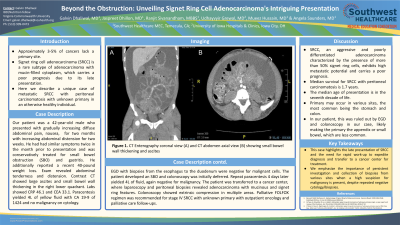Tuesday Poster Session
Category: Small Intestine
P4132 - Beyond the Obstruction: Unveiling Signet Ring Cell Adenocarcinoma's Intriguing Presentation
Tuesday, October 24, 2023
10:30 AM - 4:00 PM PT
Location: Exhibit Hall

Has Audio

Galvin Dhaliwal, MD
Southwest Healthcare MEC
RICHMOND, VA
Presenting Author(s)
Galvin Dhaliwal, MD1, Jaspreet Dhillon, MD1, Ranjit Sivanandham, MBBS1, Udhayvyir Grewal, MD2, Mueez Hussain, MD1, Angela Saunders, MD1
1Southwest Healthcare MEC, Temecula, CA; 2University of Iowa Hospitals & Clinics, Iowa City, OH
Introduction: Approximately 3-5% of cancers lack a primary site. Signet ring cell adenocarcinoma (SRCC) is a rare subtype of adenocarcinoma with mucin-filled cytoplasm, which carries a poor prognosis due to its late presentation. Here we describe a unique case of metastatic SRCC with peritoneal carcinomatosis with unknown primary in an otherwise healthy individual. This case highlights the late presentation of SRCC and the need for rapid work-up to expedite diagnosis and transfer to a cancer center for treatment.
Case Description/Methods: Our patient was a 42-year-old male who presented with gradually increasing diffuse abdominal pain, nausea, generalized weakness for 2 months with increasing abdominal distension, and shortness of breath for 2 weeks. He had similar symptoms twice the month before presentation and was conservatively treated for small bowel obstruction and gastritis. Additionally, a 40-pound weight loss was present. Exam revealed abdominal tenderness and distension. Contrast CT showed large ascites and small bowel wall thickening in the right lower quadrant. Labs showed CRP 46.1 and CEA 33.1. Paracentesis yielded 4L of yellow fluid with CA 19-9 of 1424 and no malignancy. EGD with biopsies from the esophagus to the duodenum were negative for malignancy. The patient developed an SBO, and colonoscopy was initially deferred. Repeat paracentesis 4 days later yielded 4L of fluid, again negative for malignancy. The patient was transferred to a cancer center, where laparoscopy and peritoneal biopsies revealed adenocarcinoma with mucinous and signet ring features. Colonoscopy showed extrinsic compression in multiple areas. Palliative FOLFOX regimen was recommended for stage IV SRCC with unknown primary with outpatient oncology and palliative care follow-ups.
Discussion: SRCC, an aggressive and poorly differentiated adenocarcinoma characterized by the presence of more than 50% signet ring cells, exhibits high metastatic potential and carries a poor prognosis. Median survival for SRCC with peritoneal carcinomatosis is 1.7 years. The median age of presentation is in the seventh decade of life. Primary may occur in various sites, the most common being the stomach and colon. However, this was ruled out by EGD and colonoscopy in our case, likely making the primary the appendix or small bowel, which are less common. We emphasize the importance of persistent investigation and collection of biopsies from various sites when a high suspicion for malignancy is present, despite repeated negative cytology/biopsies.
Disclosures:
Galvin Dhaliwal, MD1, Jaspreet Dhillon, MD1, Ranjit Sivanandham, MBBS1, Udhayvyir Grewal, MD2, Mueez Hussain, MD1, Angela Saunders, MD1. P4132 - Beyond the Obstruction: Unveiling Signet Ring Cell Adenocarcinoma's Intriguing Presentation, ACG 2023 Annual Scientific Meeting Abstracts. Vancouver, BC, Canada: American College of Gastroenterology.
1Southwest Healthcare MEC, Temecula, CA; 2University of Iowa Hospitals & Clinics, Iowa City, OH
Introduction: Approximately 3-5% of cancers lack a primary site. Signet ring cell adenocarcinoma (SRCC) is a rare subtype of adenocarcinoma with mucin-filled cytoplasm, which carries a poor prognosis due to its late presentation. Here we describe a unique case of metastatic SRCC with peritoneal carcinomatosis with unknown primary in an otherwise healthy individual. This case highlights the late presentation of SRCC and the need for rapid work-up to expedite diagnosis and transfer to a cancer center for treatment.
Case Description/Methods: Our patient was a 42-year-old male who presented with gradually increasing diffuse abdominal pain, nausea, generalized weakness for 2 months with increasing abdominal distension, and shortness of breath for 2 weeks. He had similar symptoms twice the month before presentation and was conservatively treated for small bowel obstruction and gastritis. Additionally, a 40-pound weight loss was present. Exam revealed abdominal tenderness and distension. Contrast CT showed large ascites and small bowel wall thickening in the right lower quadrant. Labs showed CRP 46.1 and CEA 33.1. Paracentesis yielded 4L of yellow fluid with CA 19-9 of 1424 and no malignancy. EGD with biopsies from the esophagus to the duodenum were negative for malignancy. The patient developed an SBO, and colonoscopy was initially deferred. Repeat paracentesis 4 days later yielded 4L of fluid, again negative for malignancy. The patient was transferred to a cancer center, where laparoscopy and peritoneal biopsies revealed adenocarcinoma with mucinous and signet ring features. Colonoscopy showed extrinsic compression in multiple areas. Palliative FOLFOX regimen was recommended for stage IV SRCC with unknown primary with outpatient oncology and palliative care follow-ups.
Discussion: SRCC, an aggressive and poorly differentiated adenocarcinoma characterized by the presence of more than 50% signet ring cells, exhibits high metastatic potential and carries a poor prognosis. Median survival for SRCC with peritoneal carcinomatosis is 1.7 years. The median age of presentation is in the seventh decade of life. Primary may occur in various sites, the most common being the stomach and colon. However, this was ruled out by EGD and colonoscopy in our case, likely making the primary the appendix or small bowel, which are less common. We emphasize the importance of persistent investigation and collection of biopsies from various sites when a high suspicion for malignancy is present, despite repeated negative cytology/biopsies.
Disclosures:
Galvin Dhaliwal indicated no relevant financial relationships.
Jaspreet Dhillon indicated no relevant financial relationships.
Ranjit Sivanandham indicated no relevant financial relationships.
Udhayvyir Grewal indicated no relevant financial relationships.
Mueez Hussain indicated no relevant financial relationships.
Angela Saunders indicated no relevant financial relationships.
Galvin Dhaliwal, MD1, Jaspreet Dhillon, MD1, Ranjit Sivanandham, MBBS1, Udhayvyir Grewal, MD2, Mueez Hussain, MD1, Angela Saunders, MD1. P4132 - Beyond the Obstruction: Unveiling Signet Ring Cell Adenocarcinoma's Intriguing Presentation, ACG 2023 Annual Scientific Meeting Abstracts. Vancouver, BC, Canada: American College of Gastroenterology.
